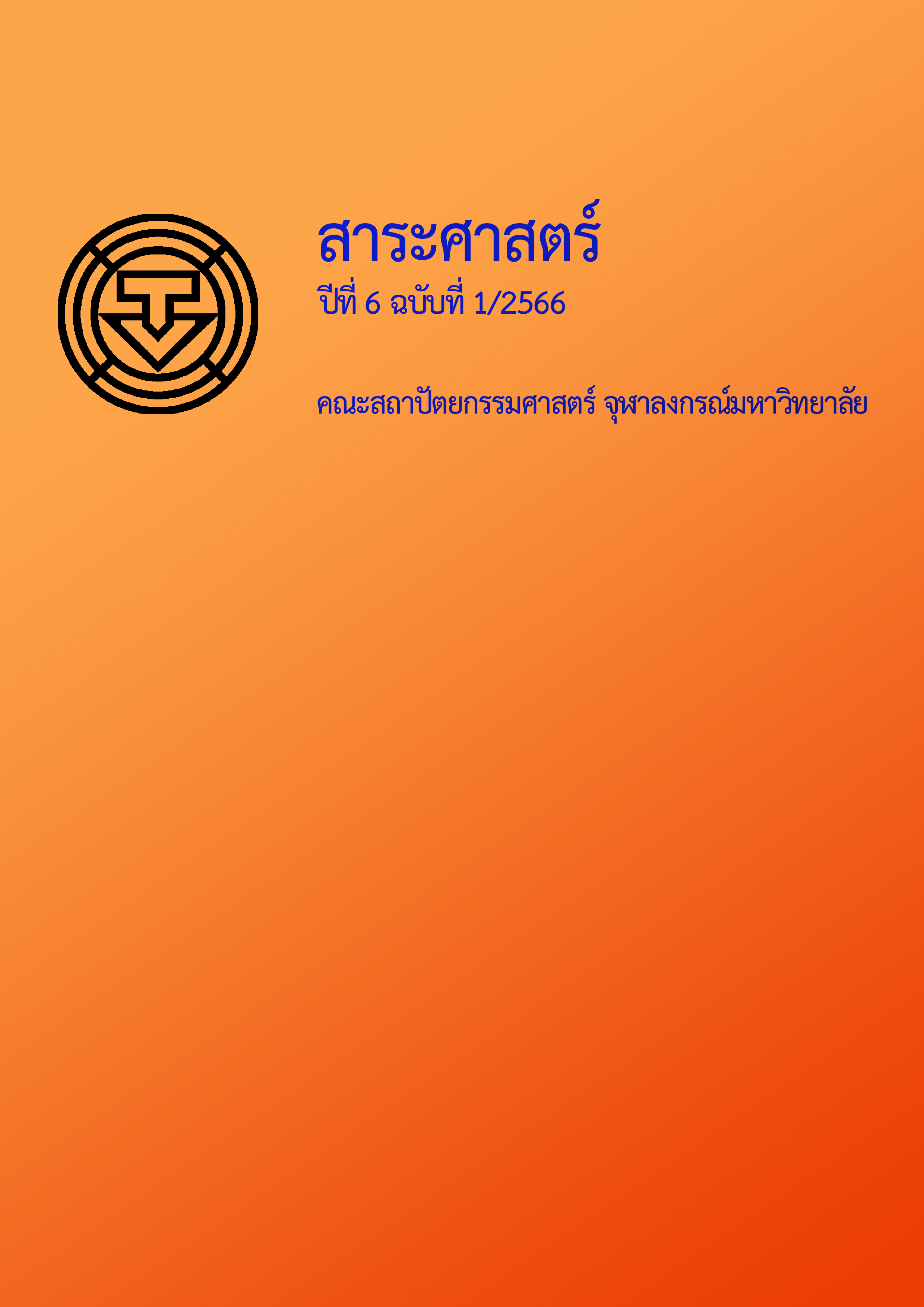Impact of Number of Opening Sides on Air Quality in Semi-open Space of Community Mall
Main Article Content
Abstract
Air quality is a significant issue that has an impact on people’s health and way of life. The dust problem and covid-19 pandemic have caused people to avoid high-density areas such as enclosed shopping malls and turn to choose community malls instead. People see a community mall as a comfortable location because of its physical characteristics of semi-open space. However, there has been no research on community malls on other aspects of comfort such as air quality. The objective of this research is to look at how the number of opening sides of a community mall and wind direction affects air quality by evaluating pollutant levels. The case study building in Bangkok was simulated by the Computational Fluid Dynamics program. The number of opening sides of the building that enable air to flow through is used to group case study buildings.
According to the CFD simulation, buildings with 4 opening sides have the lowest pollution concentration that an average ratio between indoor and outdoor pollutant concentration (I/O ratio) of 0.55 and an air change rate of 123.75 ACH. It signifies that the air quality in this building is better than in other case studies that have an average I/O ratio close to or above 1. In Addition, the orientation of the building, the direction of the wind, and the building context are all important factors in airflow. The findings of this study led to design guidelines for community malls or other buildings with semi-open space.
Article Details
References
ณัฐพร ชีวาเกียรติยิ่งยง. (2557). รูปแบบและการบริหารลานกิจกรรมของโครงการคอมมูนิตี้มอลล์ในเขตกรุงเทพฯ และปริมณฑล [วิทยานิพนธ์ปริญญามหาบัณฑิตไม่ได้ตีพิมพ์]. มหาวิทยาลัยธรรมศาสตร์.
ทรัพย์มณี ชัยแสนสุข. (2548). การลดปริมาณมลพิษทางอากาศด้วยการระบายอากาศโดยวิธีธรรมชาติสำหรับอาคารจอดรถชั้นใต้ดิน [วิทยานิพนธ์ปริญญามหาบัณฑิต ไม่ได้ตีพิมพ์]. มหาวิทยาลัยธรรมศาสตร์.
บุษกร ภู่แส. (2564). อานิสงส์‘พิษโควิด-ภาษีที่ดิน’ ดันคอมมูนิตี้มอลล์บูมรอบ 6 ปี. https://www.bangkokbiznews.com/news/detail/932230
ประกาศคณะกรรมการสิ่งแวดล้อมแห่งชาติ เรื่อง กำหนดมาตรฐานฝุ่นละอองขนาดไม่เกิน 2.5 ไมครอน ในบรรยากาศโดยทั่วไป พ.ศ. 2553. (2553, 24 มีนาคม). ราชกิจจานุเบกษา. เล่ม 127 ตอนพิเศษ 37 ง หน้า 61.
วิทวัส รุ่งเรืองผล (2559). จัดผังคอมมูนิตี้มอลล์อย่างไรให้ประสบความสำเร็จ. https://marketeer.co.th/2016/05/the-urban-land-institute/
สุพจน์ เตชะอำนวยวิทย์. (2551). การตรวจวัดคุณภาพอากาศในอาคาร. https://www.acat.or.th/download/acat_or_th/journal-14/14%20-%2009.pdf
สุรเชษฐ กองชีพ. (2562). ตลาดพื้นที่ค้าปลีกในกรุงเทพมหานครและพื้นที่โดยรอบ ณ ไตรมาสที่ 1 พ.ศ. 2562. https://www.phoenixproperty.co.th/blogs/research/86
ANSI/ASHRAE Standard 62.1-2010.(2010). Ventilation for acceptable indoor air quality. http://arco- hvac.ir/wp-content/uploads/2016/04/ASHRAE-62_1-2010.pdf
Atthakorn, S. (2019, April 26). Airflow patterns of semi-open shopping malls in Bangkok. Paper presented at RSU International Research Conference 2019, Rangsit University, Pathum Thani, Thailand.
Chakrabarty, R. K., Beeler, P., Liu, P., Goswami, S., Harvey, R. D., Pervez, S., van Donkelaar, A., & Martin, R. V. (2021). Ambient PM2.5 exposure and rapid spread of COVID-19 in the United States. Science of The Total Environment, (760), 1-7.
Chen, C., & Zhao, B. (2011). Review of relationship between indoor and outdoor particles: I/O ratio, infiltration factor and penetration factor. Atmospheric Environment, 45(2), 275-288.
Kaewrat, J., Janta, R., Sichum, S., & Kanabkaew, T. (2021). Indoor air quality and human health risk assessment in the open-air classroom. Sustainability, 13(15), 1-13.
Peng, Z., & Jimenez, J. (2020). Exhaled CO2 as COVID-19 infection risk proxy for different indoor environments and activities. Environmental, Science & Technology Letters, 8(5), 392-397.
Tantasavasdi, C., & Inprom, N. (2020). Impact of design features on natural ventilation of open-air malls in Thailand. International Journal of Low-Carbon Technologies, 16(2), 488-501.
Thai Meteorological Department. (2020). Climate data. http://www.aws-observation.tmd.go.th/web/climate /climate_past.asp
Thomas, B., Alahmad, B., Maesano, C., & Bind, M. A. (2021). The impact of outdoor air pollution on COVID-19: A review of evidence from in vitro, animal, and human studies. European Respiratory Review, 30(159), 1-18.


